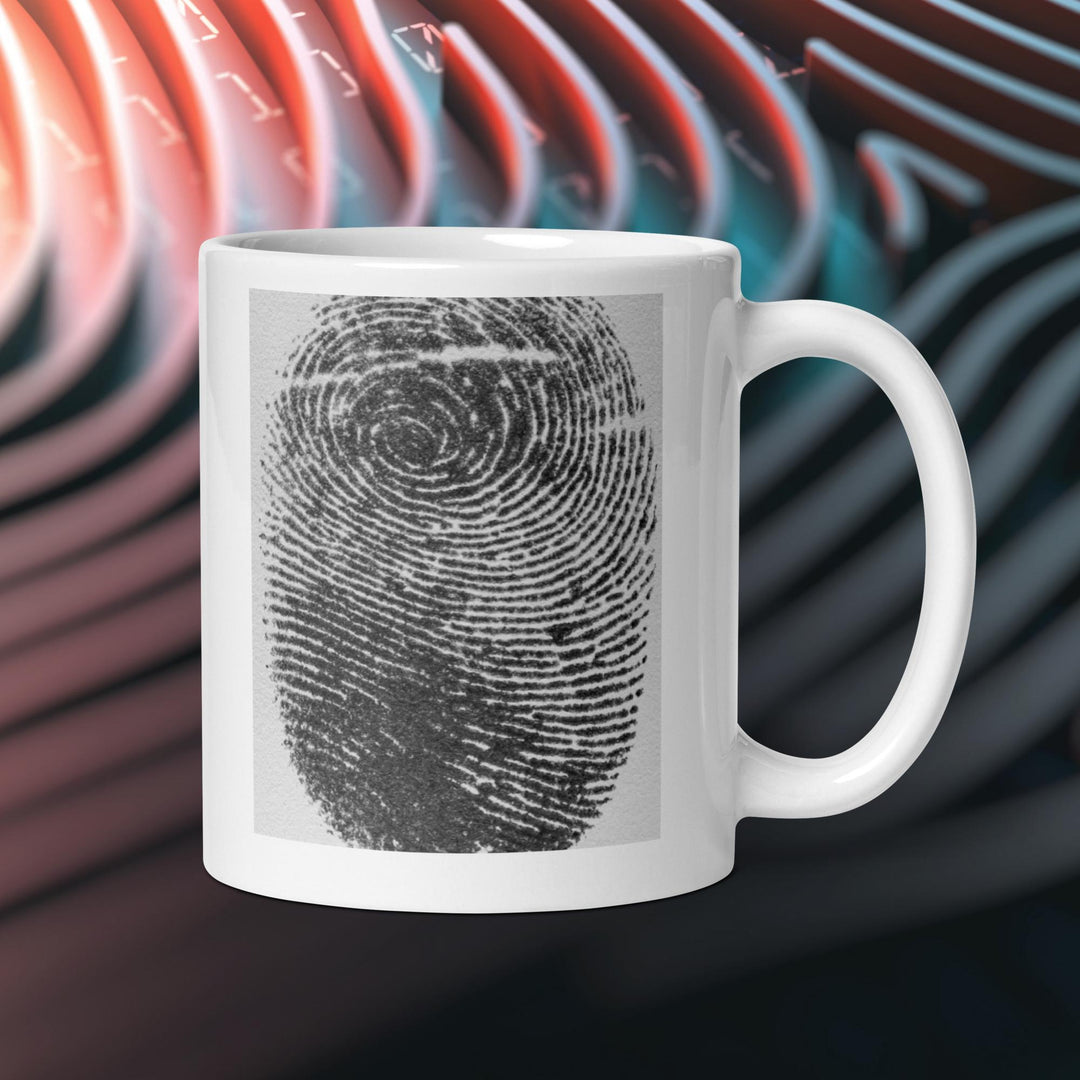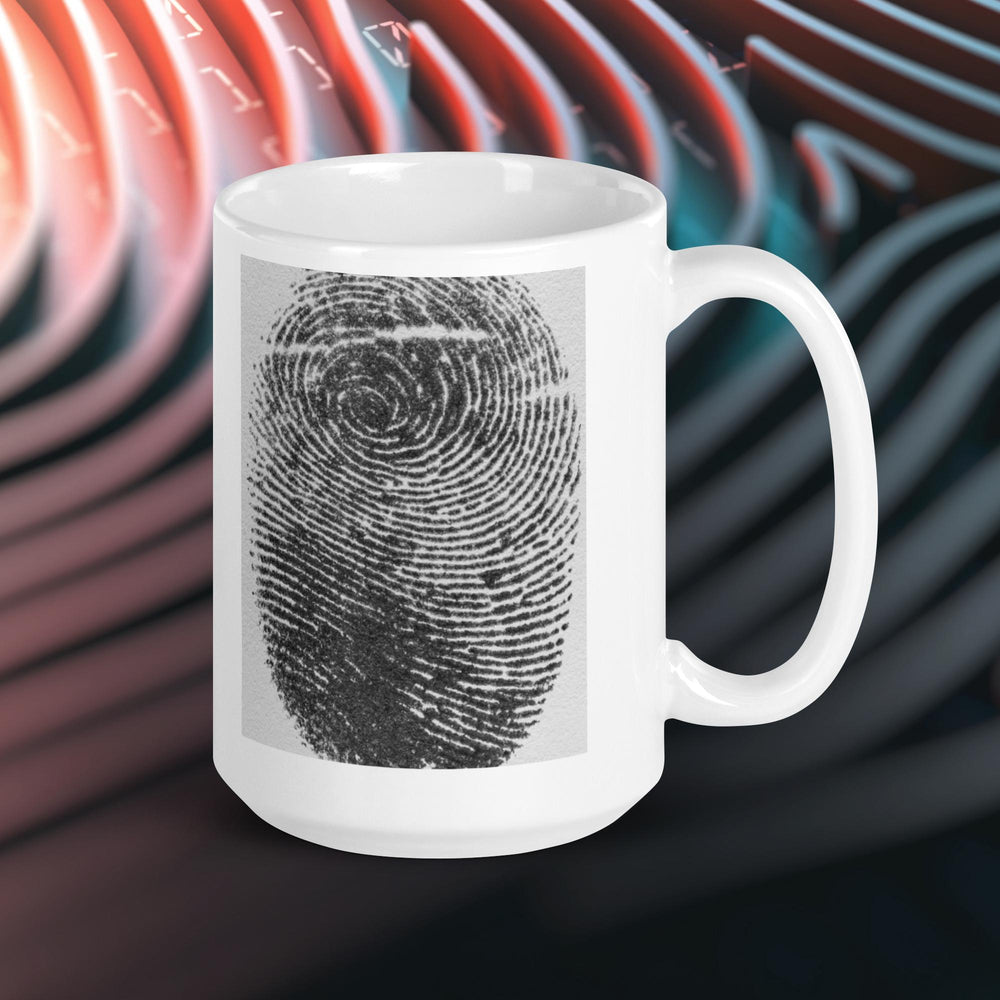Fingerprints - White glossy mug
- In stock, ready to ship
- Backordered, shipping soon
Beyond Identification: The Hidden Clues Embedded In Our Unique Fingerprints
The Science Of Fingerprints: Unveiling The Unique Patterns
The science of fingerprints, also known as dactyloscopy, is a fascinating field that focuses on the identification and analysis of unique patterns found on the friction ridge skin of human fingers. These patterns, consisting of ridges and furrows, form distinct designs that are virtually impossible to replicate. Dactyloscopy has become an essential tool in forensic investigations due to its reliability and accuracy.
The uniqueness of fingerprints lies in their intricate details. The patterns can be classified into three main categories: arches, loops, and whorls. Arches have a simple ridge pattern that flows from one side to the other without making any backward or forward turn. Loops have ridges that enter from one side and exit from the same side after making a U-turn.

Whorls have circular or spiral patterns with at least two deltas - triangular areas where ridges diverge. These patterns are formed during fetal development and remain unchanged throughout a person's lifetime unless altered by injury or disease.
Beyond Identification: Exploring The Hidden Clues In Fingerprints
Fingerprints have long been recognized as a unique identifier, aiding in criminal investigations and personal identification processes. However, recent scientific advancements have revealed that fingerprints hold more than just individuality - they can provide invaluable insights into an individual's health, lifestyle choices, and even emotional state. Researchers have discovered that the patterns and ridges on our fingertips contain hidden clues about our overall well-being.
By analyzing the chemical composition of sweat found in fingerprints, scientists can detect various substances present in our bodies. This technique has shown promise in identifying drug use, monitoring glucose levels for diabetics, and even revealing certain diseases such as cancer. Moreover, fingerprints can offer valuable information about an individual's lifestyle choices. Studies have found correlations between specific ridge patterns and smoking habits or alcohol consumption.

Additionally, stress-induced changes in fingerprint patterns can indicate high levels of anxiety or depression. These findings open up a world of possibilities for fingerprint analysis beyond simple identification.
The Origins Of Fingerprint Analysis: A Historical Perspective
The origins of fingerprint analysis can be traced back thousands of years, with early records of fingerprinting techniques found in ancient civilizations. However, it was not until the late 19th century that the modern science of fingerprint identification began to take shape. One pivotal figure in the history of fingerprint analysis is Sir Francis Galton, a British scientist who conducted extensive research on fingerprints in the late 1800s.
Galton's work laid the foundation for understanding the uniqueness and permanence of fingerprints. He also developed classification systems to categorize different patterns found in fingerprints. Another significant milestone came with the groundbreaking work of Sir Edward Henry, an English police official who developed a systematic method for classifying and identifying fingerprints. Henry's classification system revolutionized criminal investigation by providing a standardized way to record and compare fingerprints.
The adoption and widespread use of fingerprint identification by law enforcement agencies further cemented its importance as a forensic tool. Today, fingerprint analysis plays a crucial role in solving crimes and confirming identities, thanks to the dedication and contributions made by these early pioneers.
The Role Of Fingerprints In Solving Crimes: Unraveling The Evidence
The role of fingerprints in solving crimes extends far beyond mere identification, as they hold a wealth of hidden clues that can help unravel the evidence and establish crucial links between suspects and crime scenes. Each person's fingerprint is distinctive, making it an invaluable tool for forensic investigators. Fingerprints can reveal a range of information about a crime. By analyzing the patterns, ridges, and minutiae within a print, experts can determine not only the identity of an individual but also their activities at the scene.
The presence or absence of prints can indicate whether someone was present during the commission of a crime or if they attempted to conceal their involvement. Furthermore, fingerprints may hold additional hidden clues such as bloodstains or substances that could link a suspect directly to a crime scene. Advanced techniques like fingerprint enhancement and chemical analysis allow investigators to uncover vital evidence invisible to the naked eye.
In addition to physical evidence, fingerprints play a significant role in establishing timelines and sequences of events.
Unlocking Medical Secrets: Health Indicators Encoded In Fingerprints
While fingerprints have long been associated with forensic investigations and identification purposes, recent studies have unveiled a fascinating aspect of these unique patterns – their potential to serve as indicators of an individual's overall health. The ridges and valleys that form our fingerprints contain hidden clues that can provide valuable insights into various medical conditions. Research has shown that certain dermatoglyphic features, such as ridge count, ridge density, and pattern asymmetry, can be linked to specific health conditions.
For instance, individuals with a higher ridge count are more likely to have a lower risk of developing certain cancers, while those with lower ridge density may be prone to cardiovascular diseases. Furthermore, fingerprint patterns can also reveal information about genetic disorders like Down syndrome or even indicate hormonal imbalances. The analysis of fingerprints for medical purposes holds immense potential for early disease detection and personalized healthcare.
By examining the unique characteristics embedded in fingerprints, healthcare professionals could potentially identify individuals at risk of developing certain ailments before symptoms manifest.
Future Applications: From Biometrics To Personalized Medicine
As technology continues to advance, the future applications of fingerprint analysis are becoming more diverse and impactful. Beyond their traditional use in identification and forensic investigations, fingerprints hold immense potential in various fields such as biometrics and personalized medicine. Biometrics, the science of identifying individuals based on their unique physical or behavioral characteristics, is rapidly evolving with fingerprints at its forefront.
Fingerprint recognition systems are being integrated into smartphones, laptops, and other devices for secure access control. In the future, we can envision a world where fingerprints may replace traditional passwords altogether. Moreover, fingerprints could play a significant role in personalized medicine. Recent studies have shown that certain medical conditions leave specific patterns on our fingertips that can be detected through advanced imaging techniques.
By analyzing these unique patterns, doctors may be able to identify early signs of diseases such as cancer or diabetes. This non-invasive method could revolutionize early detection and improve treatment outcomes. Furthermore, understanding the genetic components of fingerprint formation may lead to breakthroughs in genetic research.
Whether you're drinking your morning coffee, evening tea, or something in between—this mug's for you! It's sturdy and glossy with a vivid print that'll withstand the microwave and dishwasher.Design on both sides.
• Ceramic
• 11 oz mug dimensions: 3.8″ (9.6 cm) in height, 3.2″ (8.2 cm) in diameter
• 15 oz mug dimensions: 4.7″ (11.9 cm) in height, 3.3″ (8.5 cm) in diameter
• 20 oz mug dimensions: 4.3″ (10.9 cm) in height, 3.7″ (9.3 cm) in diameter
• Dishwasher and microwave safe
• Blank product sourced from China
This product is made especially for you as soon as you place an order, which is why it takes us a bit longer to deliver it to you. Making products on demand instead of in bulk helps reduce overproduction, so thank you for making thoughtful purchasing decisions!
Use collapsible tabs for more detailed information that will help customers make a purchasing decision.
Ex: Shipping and return policies, size guides, and other common questions.











